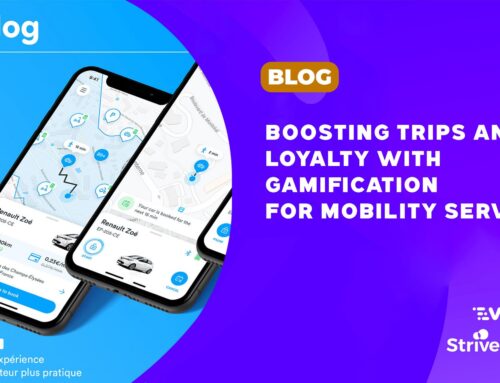How the shared mobility industry can benefit from app gamification
While e-scooters are extremely popular and provide a good solution for short-distance commute in cities, the micro-mobility industry is struggling to make ends meet. The main reason is strict regulation leading to little differentiation with competitors. Embracing app gamification could, however, bring shared mobility providers more peace of mind and strengthen their position in the fierce battle to build a loyal user base.
Shared mobility solutions provider Wunder Mobility, is teaming up with StriveCloud to introduce app gamification and its benefits to clients.
In this article you’ll find out about:
In January 2020, location technology specialist, TomTom released the results of the TomTom Traffic Index. The report details the traffic situation in 416 cities in 57 countries. The latest issue states that 239 cities (57%) saw higher congestion levels in 2019 compared to 2018. Despite traffic being an indicator of a strong economy, congestion is a huge obstacle: it costs an economy billions.
Dedicated to beat this standstill, shared mobility players have entered the playing field, giving us more possibilities to get from one place to another. Shared mobility is a term used to describe transportation services that are shared among users.
The rise of e-scooters
A new category of portable, fun, and compact shared transport devices was launched in 2018, the so-called scooters or kick-scooters. They are electrically powered and can reach speed levels of up to 30- 40km/h. Often referred to as micro-mobility, shared e-scooters are made available through an app-based service that locates the device through GPS and unlocks it with the help of a smartphone.
E-scooters certainly are fast-growing transport technology. They are popular because they cater perfectly to the rising demand for quick solutions to bypass congested traffic with little effort. According to the New Urban Mobility Alliance NUMO – an alliance organization of cities, NGOs, companies, mobility service operators, and community advocates – micro-mobility is now available in 626 cities spread over 53 countries. In 2019, 300 million e-scooter trips were made globally with figures expected to increase at a significant pace in years to come.
“We are witnessing a new transportation revolution, and shared mobility is a significant catalyst.” – Harriet Tregoning, Director @NUMO
Significant roadblocks
Despite exceptional growth over the past years, the micro-mobility market faces important challenges including regulatory demands, limited infrastructure, and competitiveness.
#1 Strict regulation
The market is under strict regulation by cities. Local governments put out tenders setting operational, safety, and sustainability requirements the shared service providers have to meet. Each provider should, for instance, provide a fixed number of scooters with tech revisions made according to regulations. That doesn’t give a lot of room to differentiate from the competition.
#2 Poor hardware health
Despite demands in terms of quality, fierce competition between micro-mobility providers forces players to cramp out enormous volumes of cheap vehicles fast. Unfortunately, this often means quality suffers.
When bikes or scooters break and you don’t fix them in a timely manner, users get frustrated having to test several bikes before finding one that works properly. This can ultimately damage the public’s perception of your company.
#3 Trouble turning profits
Even though many micro-mobility companies have been able to convince investors and raise millions of dollars (according to consulting firm McKinsey, stakeholders have invested more than $5.7 billion since 2015), numerous are struggling to achieve sustainable profitability. One of the main reasons for the difficult financial situation is the fact that, due to strict regulations, many providers can only compete at the price level.
One example is the Chinese bicycle-sharing company Ofo. In 2017, it was valued at up to $2 billion and had over 62.7 million monthly active users. In early 2018 it received a $2.7 billion investment. Just a few months later, it considered declaring bankruptcy over cash flow issues.
The breakdown of unit economics of e-scooter company Bird below shows an example of how small the profit margin actually is for a given scooter ride.
How in-app gamification helps profitability
Gamification is a proven tactic to solve the challenge of acquisition and retention. Gamifying an experience doesn’t mean you have to create a game. It is about taking customer data and creating milestones, levels, challenges, rewards, leaderboards, and all other gamification elements to create a fun and rewarding experience.
App gamification has 3 significant benefits:
- As a company, you can stop worrying about competing on price and, instead, differentiate through the competition.
- Gamification allows you to gather more key data about your users. By linking important metrics – such as the number of rides, the distance they drive, and how many minutes this drive takes them – to milestones and challenges, you get users to come back. As a result, you will be able to generate even more data. This information is precious when making decisions to grow your company further or when assessing performance in cities in which you’re active. So the bigger your data sample, the more informed decisions you can take.
- It gives you the chance to cut down on the costs of the redistribution for vehicles. Instead, smart gamification tactics such as achievements and rewards allow you to motivate people to leave scooters in designated areas.
If you want to know more about gamification, read this post!
The partnership between StriveCloud and Wunder Mobility to help providers build a connection with users
Following the interest from several of its clients, Wunder Mobility is now teaming up with StriveCloud to introduce the wonders of app gamification to the shared mobility industry. StriveCloud will offer a plug-in toolkit of several gamification elements, allowing providers of shared mobility services the chance to experiment.
Providers will, for example, be able to give users the possibility to unlock achievements when they reach a certain number of drives or a certain distance traveled. Another option will be able to link drop-off locations to rewards, which can be very useful to steer user behavior. A third tactic that will be made available is raffles, a lottery the users can enter with tickets they gather when riding. The exact gamification elements are to be picked during a workshop between StriveCloud’s gamification specialists and the provider’s team.
Curious to see what gamification could look like for your product or service? Book a demo with one of our experts and discover how you can benefit from our technology!
With competition in the shared mobility industry getting fiercer every day, it’s necessary to think about how you can differentiate yourself from other players and keep attracting users. In-app gamification is one of the major opportunities to build that strong and loyal user base your company needs to thrive.
Since the whole sector is currently on the lookout for ways to improve user acquisition and retention, the time is now to start experimenting.




